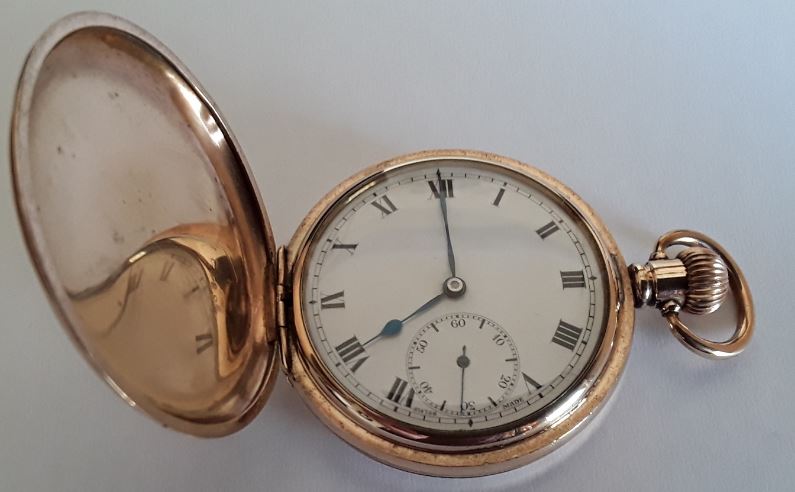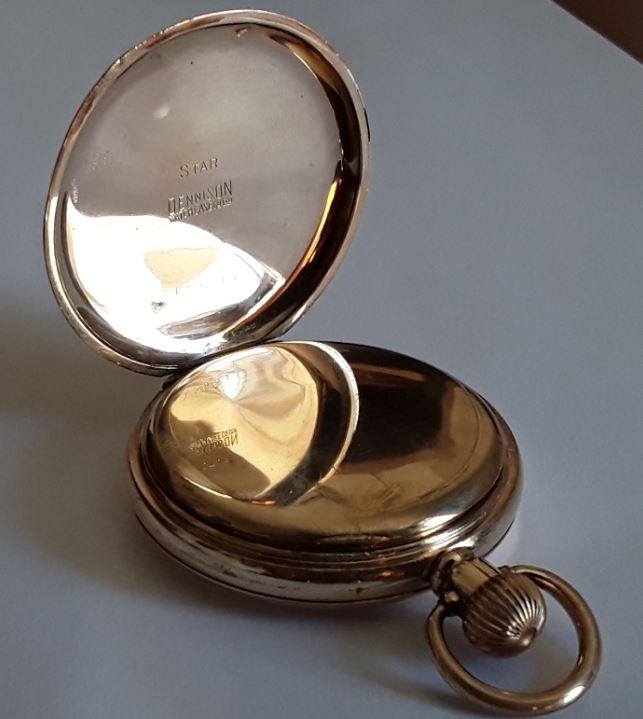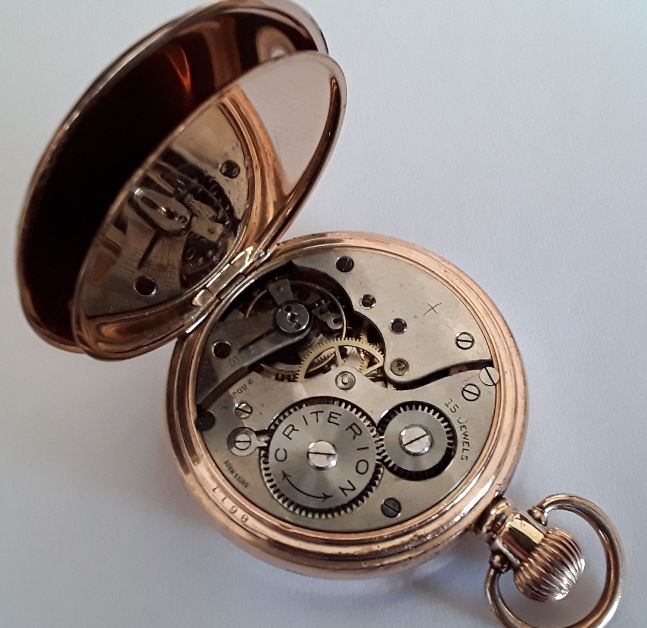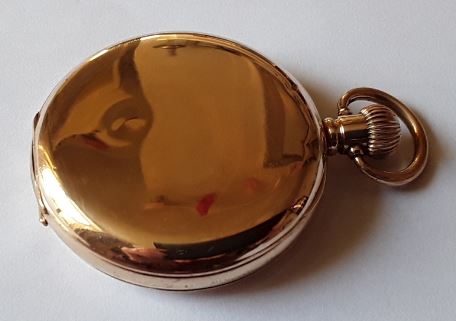Last updated on May 30, 2024
Anyone who has read my recent posts would know that I have been looking for an antique hunter cased pocket watch. I have been looking for several weeks without luck. There were plenty of hunter pocket watches from the 1920s and 30s, but these didn’t qualify as genuine antiques. Finally, I managed to find this Criterion full hunter pocket watch, which could be confidently dated to around 1910.

Age
The watch was listed as being early 20th century, which wasn’t enough to guarantee that the watch was a genuine antique. It was possible that a maker’s mark beneath the dial might reveal the age, but really all I had to work on were the markings on the Dennison case.
Inside the gold-coloured case back is the Dennison Star symbol, the company name and a serial number, 155611. The Star symbol indicated that the outside of the case was a layer of 9-carat rolled gold, guaranteed to wear for 10 years. The inside of the Star case, which naturally was subject to less wear, was electroplated with gold plate to reduce costs.

The company name is marked as ‘Dennison Case Co Ltd’. This is the first clue as to the age of the case and subsequently the pocket watch. The Dennison watch case company was founded in the 1870s. In 1905 it became a limited company. This dates the case to 1905 at the earliest. The only other mark that could be used to further date the case was the serial number.
Dennison serial numbers
There is no online register of Dennison serial numbers. In fact, there is no common agreement in online circles about the sequencing of serial numbers for Dennison cases. It could be that the serial numbers were allocated randomly. However, I am going to make the assumption that the serial numbers incremented over time. I looked at a fair number of antique watches that were dated from the movement and had Dennison Star cases. In nearly every instance, the older the watch, the lower the serial number.
The serial number on my Dennison Star case is 155611. I found a reference to a watch made by the Lancashire Watch Co of Prescot, the movement wasn’t dated, but the Dennison Star case had the serial number 256244. The Lancashire Watch Company went out of business in 1910. This, therefore, dates my case somewhere between 1905 and 1910.
Movement
The watch has a Swiss made 15-jewel stem-wind, stem-set movement, which is ticking along nicely as I type. The movement is signed Criterion, which is a brand name registered by various watchmakers. However, this one has been determined to be from Achille Hirsch of La Chaux-de-Fonds, Switzerland. Achille Hirsch registered the Criterion name in 1897. The movement is protected by an inner hinged cover which has a small “ding” and a little scratching. The inner dust cover contains the wording for the 10-year guarantee of the Star case. The movement is also marked “two adjustments”, which means it has been adjusted to the horizontal positions.

Case
The watch measures 50mm in diameter excluding the winding stem and the loop. The case has three very minor “dings” to the back and some fine scratching. However, overall, it is in good condition for its age and remains a very presentable watch.
The winding crown pushes in to open the front lid. There is a slight stutter when it opens, but it is barely noticeable and totally reasonable for a watch of its age. It’s good practice to remember to depress the crown when closing the lid to preserve the life of the spring. Inside there is an acrylic crystal lens which is in good condition. The enamel dial looks clean and sharp to the naked eye, although with a jeweller’s loupe, you can see a short faint hairline between 4 and 5.
The dial has blued steel hands, a subsidiary second’s dial and an outer minute track. Bluing steel is a process that tempers the steel and creates an oxidised coating that helps to prevent the hands from rusting. Initially, the steel hands are cleaned and polished. Next, the hands are heated, over a bed of brass filings, to a high temperature. The layer of brass filings is used to maintain a stable temperature exchange. The steel changes colour from gold to brown and then purple before it settles to blue.

The watch passed a 24-hour time test with flying colours within a minute’s accuracy over the period when compared to the time on my PC. It’s been a long wait to find my first antique hunter case watch, but I am very pleased with my purchase. It’s presentable, practical and accurate. I can’t wait for my first opportunity to wear this antique pocket watch. Now I need to decide what to look for next.

I have a criterion as well. It was my grandfathers and bought before his marriage in 1901. It looks very similar t yours apart from being a half hunter. It keeps quite good, time given that I don’t think it has ever been serviced! From my limited research it shows as being made between 1895 and 1900 by Criterion which apparently was a trade name used by Ingersoll in the UK. My research continues.
Hi Andy, the Ingersoll Watch Company grew out of a mail order business started in New York in 1882 by Robert Hawley Ingersoll and his brother Charles Henry Ingersoll. The company initially sold low-cost items such as rubber stamps. The first Ingersoll watches were introduced in 1892. These were “affordable” timepieces made by the Waterbury Clock Company. In 1896 Ingersoll introduced the “dollar” watch. It was a cheaply mass-produced watch made from stamped parts and without jewels. It was effectively the first disposable watch. Buy it, wear it and when it became inaccurate, you would toss it away and buy another. In 1904 Ingersoll opened a store in London, England. In 1922, the American company went bankrupt. It was purchased by the Waterbury Clock Company, which eventually became Timex. The British company Ingersoll Ltd was purchased by its directors and continued to run independently.
Both the American and British versions of the Ingersoll company focussed on producing “affordable” watches. A good quality, Swiss Made, 15-jewel movement would not fall into this category. If your watch dates from 1901, it would pre-date the 1904 opening of the London branch. It is possible that Ingersoll was exporting their Waterbury Clock Company watches into Britain, but these would have been made in the US and would not have been stamped with Swiss Made or include a Dennison case. If you search on the Mikrolisk website (The horological trade mark index) for Criterion, you will see that the name was registered in Switzerland by Achille Hirsch in 1897. If your watch is Swiss Made with a Dennison case I think this is the most likely watchmaker. I hope this helps, thanks for commenting, Jason
Glad I found this information, I too have exact same watch albeit the half hunter but everything else is identical including no name on dial just says swiss made,serial on my Dennison case is 482121,found Ingersoll(Criterion) database which said 1894 but think inaccurate as i know case is maybe 1920s,was my great grandfathers,passed down to me,would love to know if hallmarks on case decide when watch was made,runs and keeps good time,thanks
Hi James, I’m glad this post was useful. Ingersoll was an American company that was famous for the “dollar watch”, an affordable, “disposable” watch. If your watch is signed “Swiss Made” on the dial it is likely to be a much higher quality Swiss brand. The Dennison Watch Case Company was based in Birmingham and mainly produced for the British market, although it did case some American brands. Dennison watch cases are notoriously difficult to date from the serial number. However, if the case is precious metal, solid silver or gold, it is possible to date using the British hallmarks. Your watch movement, being Swiss made is likely to be by Achille Hirsch. According to Mikrolisk, The brand name “Criterion” was registered by Achille Hirsch in 1897. I hope this helps and thanks for taking the time to comment, Jason.
Thanks for reply,after some searching the gold stamp relates to Birmingham,1930 which is about right as I thought 1920s originally